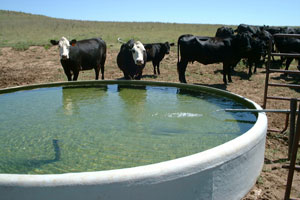Gov. Fallin Appreciates Expedited Cost-Share Program

The Oklahoma Conservation Commission has announced Program Year 14 of the state’s Locally-Led Conservation Cost-Share Program. The agency approved guidelines for the latest program at its Aug. 13 meeting. The program began in 1997 with the goal of reducing soil erosion and improving water quality by providing financial assistance to landowners for applying soil and water conservation practices. Funding for Program Year 14 is a record $1.4 million. A few changes were made with the goal of going further to help landowners recover from the effects of the exceptional drought this year.
One change is that the program is being opened up earlier than most years. The Cost-Share Program overlaps years because it is designed to extend through two growing seasons to allow ample opportunity, under normal conditions, to install the conservation practices. In past years the program has opened at different times of the year from October to February, and the run for 16-24 months for completion of the installation of the practices. Most years the program has begun in October. However, the first year of the Cost-Share Program, 1997, it began in August, also a year of exceptional drought.
“This year’s drought has unfortunately meant losses for many of the state’s agricultural producers,” said Governor Mary Fallin. “It’s important we do everything we can to help them recover. The conservation cost-share program is a great way of assisting our farmers and ranchers as they respond to this difficult summer. I appreciate the Conservation Commission working to expedite the necessary funds.”
“We want to open up this year’s program as soon as possible so that local conservation districts can make it available to help landowners, farmers and ranchers, who have been impacted by the severity of the drought,” said Mike Thralls, Conservation Commission executive director.

Last year, in 2011 – another year of extreme drought – the installation of a pipeline to move water from a supply source to a point of use for livestock was approved for the program. Previously, the installation of pipelines was only covered in the creation of a new watering facility. Now as a stand-alone practice, a pipeline can be installed in an existing watering system. This change is intended to help rotational grazing operations by providing additional locations to water livestock. The program also now includes assistance with new well construction and reestablishment of grass as well as an original practice, the construction of new ponds for additional water storage when rains occur. In addition, brush control assistance is available to remove eastern redcedar from pasture and rangeland. Eastern redcedars rob moisture from grass and pose a danger from wildfire.
Practices in the Conservation Cost-Share Program vary across the state according to priorities set by the local conservation district board of directors. Some of those available that also provide benefits during dry weather include constructing ponds, installing water troughs or tanks and drilling new wells.
Practices that help reduce soil erosion during wetter periods are also included in the Conservation Cost-Share Program. Those practices are terraces, grassed waterways, diversions, critical area planting and grade stabilization structures. Additional practices available are fencing, pasture and hay planting, range planting, nutrient management and pest management.
